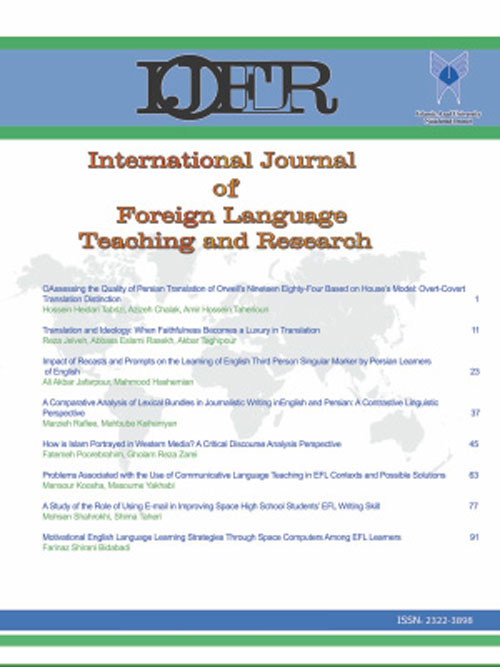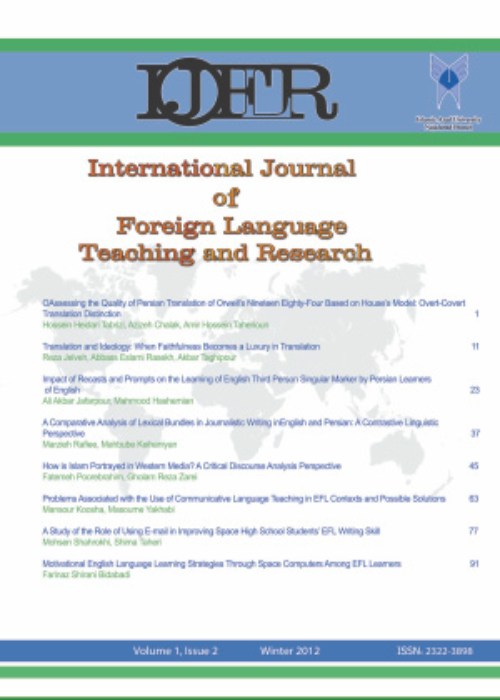فهرست مطالب

International Journal of Foreign Language Teaching and Research
Volume:3 Issue: 12, Winter 2015
- تاریخ انتشار: 1394/12/19
- تعداد عناوین: 6
-
Pages 11-24This paper focuses on the most prominent theta roles used in the Sindhi language. The study attempts to answer to the research question, How are theta roles prominently used in the Sindhi language? The data come from the young native Sindhi speakers. Each verb phrase in the data is examined with the help of Carnies (2007) Theta Roles and Thematic Relations in order to find the prominent theta roles in the Sindhi language. The study finds six prominent theta roles in Sindhi; namely, agent, theme, beneficiary, recipient, goal and locative. According to the findings of Rappaport Hovav (2007), the hierarchy of the theta roles in English is: Agent> Recipient>Experiencer/Goal>Instrument>Patient/Theme>Place; while, the hierarchy of the prominent theta roles in the Sindhi language is: agent>theme>beneficiary>recipient> locative>goal. This finding is not, however, definitive, i.e. broader studies are to be carried out to find the precise hierarchy of the theta roles in Sindhi.Keywords: Syntax, semantics, Theta roles, prominent Theta roles, English, Sindhi
-
Pages 25-40This study was intended to compare collaborative and individual task planning effects on Iranian EFL learners writing performance. Therefore, a group of 90 upper intermediate EFL learners were placed in three groups of Collaborative Task planning, Individual Task planning, and Control. In the experimental groups, participants were asked to do task planning collaboratively and individually. The first writing assignment was the pretest and the eighth one was the posttest. A rating scale which includes five equally weighted criteria for rating; namely, Organization, Content, Grammar, Mechanics, and Style as well as the Total score was used. After making sure about the inter-rater consistency, data were analyzed using one-way ANOVAs to examine the effects of task planning on EFL writing performance. Results indicated that task planning produced better writing performances in the experimental groups, when considering Total scores. Furthermore, the treatment was effective in Organization and Style. Nevertheless, it had no significant effects on Content, Grammar, and Mechanics. Results are in line with previous research on collaborative writing and task planning. However, the study was different because it made a distinction between collaborative and individual task planning. This study has practical implications for classroom practices and language teachers, and theoretical implications for a better understanding of sociocultural theories of second language learning.Keywords: collaborative writing, task planning, sociocultural theory of second language
-
Pages 41-51During the course of the past few decades, teachers have increasingly become the center of attention in education, since their significant role in teaching contexts has been approved, and therefore their different aspects, such as reflective teaching and burnout have received great attention. This study investigated the relationship between teacher burnout, and reflective teaching among Iranian EFL teachers. To this end, 50 participants (25 males and 25 females) were selected through convenience sampling. The participants were administered Maslach Burnout Inventory-Educators Survey and Behzadpour Reflective Teaching Questionnaire. The data were analyzed using Pearson product-moment correlation coefficient. The results of the study revealed that there was a weak negative relationship between reflective teaching and burnout for male and female teachers and for both groups considered as a composite group of language teachers.Keywords: Teacher burnout, reflective teaching, reflection, demographic, EFL teachers
-
Pages 53-71The changing culture toward multimodality enforces acquiring visual literacy in every aspect of todays modern life. One of the fields intermingled with using various modes in different variations is language teaching and learning, especially for and by young learners. Young language learners (5-12 years old) lack of world experience forces them to make the most use of non-verbal modes of communication to receive and send the intended message, enhanced in foreign language learning environment. As a result, the language teacher him/herself will be supposed to be armed with visual literacy of this new language and to have the ability to successfully transmit this knowledge to the students. The present study aims to investigate whether the three focused factors in educational semiotics; namely, Process of abduction, Principle of kinesics, and Proxemics- proposed by Sert (2006) exist in the curriculum of Iranian pre-service language teachers in one of the educational districts in Isfahan. By distributing two questionnaires among TTC course instructors and pre-service teachers, and obtaining the percentage of the analyzed data, the findings showed that the number of institutes which focus on the matter are rare. Also, it was revealed that the pre-service teachers, majoring in English Language, performed better in terms of realizing the meaning of body language units and comparing and contrasting them (principle of abduction). The results will be useful for future teachers and their educational curriculum in favor of enhancing the fifth language skill, foreign language visual literacy.Keywords: English Teacher Training, Educational Semiotics, Visual Literacy, Children
-
Pages 73-86Translation is a process which needs concentration and a relaxed mind. Obsessive compulsive disorder (OCD) is a mental disorder which causes the patients to repeat something continuously so that it is done in the best way. As both translation and OCD are mental processes, this study has investigated the relation between these two mental processes. For this purpose, at first Oxford Placement Test was given to 100 advanced university translation students. Then, 40 participants who were at the same level of language proficiency were given Yale-Brown Obsessive Compulsive Scale (Y-BOCD) test to check the degree of their disorder. They were then asked to translate a chosen text. The rater suggested 40 minutes for the translation of this text and asked the participants to estimate the duration of their translation. The data were then studied based on Holmess map of translation studies (Holmes 1988). The results showed that OCD affects both translation accuracy and translation time. The findings of this research makes translators informed that mental processes can affect translation processes. In fact, translators with OCD need more time for translation, which causes some problems in cases when urgent translation is needed. Based on the results of this study, it is clear that translators with OCD problems are not reliable for translation tasks.Keywords: Obsessive Compulsive Disorder, performance, semantic translation, translation accuracy
-
Pages 87-96Armed with technological development, the present study aimed at gauging the effectiveness of exposure to news and movies as two types of audiovisual programs in improving language learners listening comprehension at the intermediate level. To this end, a listening comprehension test was administered to 108 language learners and finally 60 language learners were selected as intermediate language learners and randomly divided into group one and group two. During the experiment, group one participants had exposure to audiovisual news stories to work on in and outside the classroom. On the contrary, the participants in group two had only exposure to a sample selected utterances extracted from different kinds of movies. At the end of the experiment, both groups took another sample listening test to find out to what extent the participants in each group could enhance their listening comprehension. The results obtained from the posttest were indicative of the fact that the participants who had exposure to news outperformed the participants who had exposure to movies. The findings of the present research seem to indicate that the language input embedded in the type of audiovisual programs which language learners are exposed to is more important than the amount of exposure.Keywords: Audiovisual news, Movies, listening comprehension, Intermediate level


